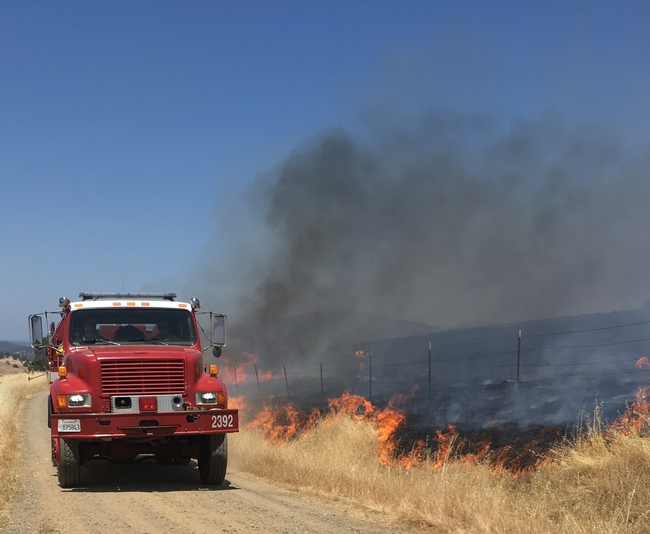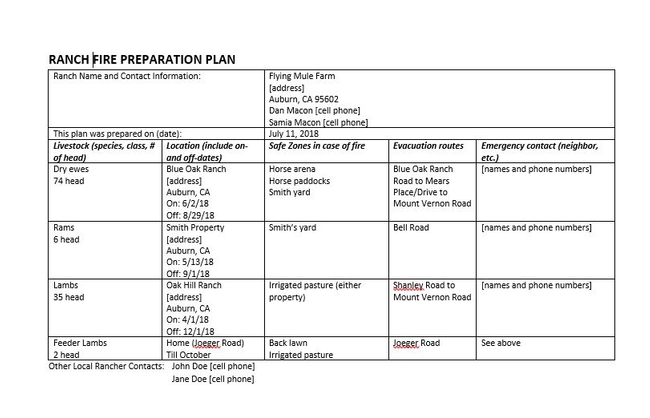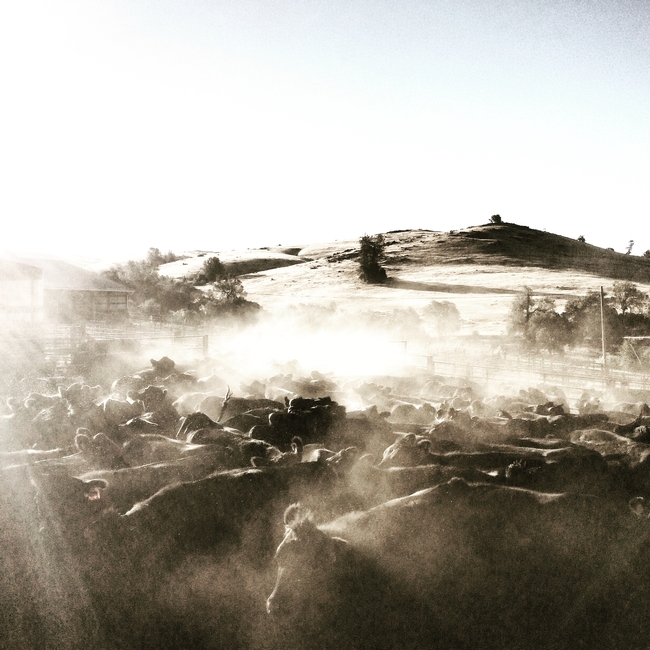- Author: Dan Macon
With the month of May upon us, wildfire season (at least here in the Sierra foothills) is just around the corner. Indeed, May is Wildfire Awareness Month - the National Interagency Fire Center website is a great source of information on steps we can all be taking to make our communities, ranches, and homes more fire safe and fire resilient.
If you operate a ranch in Nevada, Placer, or Yuba County, one of the first steps you should consider taking is registering for this year's Disaster Livestock Access Program. Developed last year by a steering committee comprised of local ranchers, agricultural commissioners, and UC Cooperative Extension, the Disaster Livestock Access Program is designed to coordinate with emergency managers to provide ranchers with access to livestock in evacuation zones for the purpose of feeding, watering, and caring for commercial livestock.
Our program is unique in that our geographic coordination mirrors that of our local CALFIRE unit (which reflects the on-the-ground reality that many commercial ranches operate in multiple counties). Each county will recognize a pass issued by any of these three counties (Nevada, Placer, and Yuba).
Who qualifies for a Disaster Livestock Access Pass?
For the purposes of this program, a commercial livestock operator is defined as owning or managing 50+ head of livestock (including in utero, e.g., 25 bred cows), 100+ poultry or rabbits, or 50+ beehives that reside in Placer, Nevada, or Yuba County for at least a portion of the year. Cattle, sheep, goats, hogs, poultry, rabbits, llamas, alpacas, and bees that are "commercially raised" (e.g., as part of a business) qualify for the program. The program applies to both private land (owned or leased) as well as to public land (including US Forest Service and BLM grazing allotments).
Will a Disaster Livestock Access Pass get me through a road block?
Not necessarily. Your local agricultural department and I will work with incident command to identify areas within evacuation zones that are safe for passholders to access. Refer to the incident flowchart below for more details.
How do I get a Disaster Livestock Access Pass?
To enroll in the program, you must provide contact information, APNs, physical addresses, and/or allotment names of grazing sites, general season(s) of use, livestock description and inventory, and release of liability. You can register online at the N-P-Y Disaster Livestock Access Registration Site or by contacting me directly at dmacon@ucanr.edu or (530) 889-7385. Ranchers will need to apply each year; even if you received a pass in 2021, you'll need to complete this registration process again this year.
Is training required?
If you haven't held a pass previously, you'll need to participate in a 4-hour training session on Saturday, June 4, 2022, from 9am to 1pm at the UC Sierra Foothill Research and Extension Center in Browns Valley, CA. This training will provide an overview of the program, information on the incident command system and wildfire behavior, and an opportunity to ask questions with local law enforcement, emergency services, and CALFIRE. If you held a pass last year, you'll need to participate in a 1-hour virtual refresher course currently in development.
Preparation is Key!
Three days before our first 2021 training session, the River Fire tore through parts of Placer and Nevada Counties. Several of the ranchers who came to the workshop were able to describe the chaos and confusion of the early hours of the fire - as well as the need to coordinate with law enforcement and fire officials on the fly. Hopefully this program will improve our ability to communicate during an emergency - and provide access to care for livestock.
If you have questions, please contact me at dmacon@ucanr.edu or (530) 889-7385.
- Author: Dan Macon

Earlier this week, a number of ranchers from Placer County met with law enforcement, fire and animal control officials to discuss the emergency preparation and response issues unique to commercial-scale ranching operations. As we talked, I realized that there are several factors that make planning for and responding to wildfire (and other emergencies, like flooding) challenging for these kinds of ranching businesses:
- Many ranches have livestock in multiple locations.
- Many leased pastures are simply pastures; there is no landlord or other resident on site.
- Because of this, the physical address of the pasture may not be readily apparent.
- Often, the number of livestock at a particular site may be more than can be easily evacuated in a single load in a stock trailer.
- Access during a fire may be difficult due to law enforcement road blocks. Since many of us lease pastures, gaining access (as opposed to staying at our home places in the event of an evacuation) can be problematic.
There are several things we can do to help address these issues. First, we should write down the locations where our livestock are grazing at least on a seasonal basis. What's the address? How many animals are at each location, and what classes of animals are there? What are the evacuation routes you'd be likely to use to get animals out of harms way? If you couldn't evacuate the animals, are there safe zones on or nearby the location where animals could be moved? Is there an on-site landlord or resident, or perhaps a neighbor, that you could call in an emergency situation? Finally, are there 2 or 3 nearby ranchers who could help you? Here's a sample of my one-page plan:
Access to leased pastures during a large-scale fire or other emergency may be more problematic. On Monday, we learned from CalFire that there is a liaison officer within the agency's incident command structure who can help facilitate access to livestock during a multi-day fire. Short-term access may be more difficult - we're working with our local emergency responders to find ways to address this while also protecting public and fire fighter safety.
What steps do you take to prepare for the possibility of wildfire? I hope you'll share your ideas and questions in the comment section below!
And finally, I'm working on organizing similar meetings with first responders in Nevada, Yuba and Sutter Counties. If you operate a commercial ranch, or lease land to a rancher in one of these counties, and would like to get involved, please contact me at dmacon@ucanr.edu.
- Author: Dan Macon
The Detwiler Fire in Mariposa County (which has burned over 45,000 acres as of this post) reminds us that California's annual rangelands are especially vulnerable to wildfire. After record-setting rainfall in the just-concluded precipitation year, we have an unusual amount of fine fuels (dry grass and forbs). And after our just-concluded 500-year drought, we're still coping with significant tree mortality problems, especially on the west slope of the southern and central Sierra Nevada. (As a side note, I drove through the region currently impacted by the Detwiler Fire last fall - the number of dead Ponderosa pines was astounding). For me, at least, the threat of wildfire is a top-of-mind issue every year until the fall rains begin. I'm sure that those of you who also graze livestock on annual rangelands during the dry season feel the same way!
For me, there are three areas where I focus my attention when it comes to the threat of wildfire. The first is situational awareness. Obviously, when I'm checking sheep or building fence, I keep an eye on my surroundings - a puff of smoke commands my attention immediately. I'm cognizant of wind and humidity, as well. A fire plane makes a distinctive sound - a low flying fire plane suggests that there's a fire close by. Even when I'm sitting in my office (which is about 8 miles from our annual rangeland pastures), I listen for the sound of firefighting aircraft - the rest of the staff in Auburn is now used to seeing me run outside to look for smoke when we hear planes go over this time of year!
The second is preparation. As we enter fire season, we talk about where the sheep will be and where we might be able to move them if a fire threatens. While hauling the sheep out of harms way is our preferred option, we also discuss potential safe areas, including nearby irrigated pastures, green belts or areas cleared of vegetation. I also carry a McLeod fire tool and a 5-gallon backpack pump in my truck - it's important to be prepared.
The third area of focus is response. Fortunately, in the 15 years we've raised livestock commercially, we've never had to respond to a fire directly threatening our animals. We have lost fences on leased properties to fire, but we've never been forced to evacuate (for which I'm very grateful). As fast as the Detwiler Fire is moving, I suspect we wouldn't have much time to respond. Our option of last resort would be to let the fences down and hope that the ewes and the guard dogs get somewhere safe.





